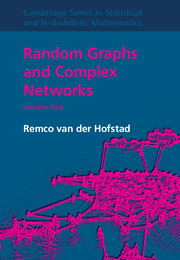1 - Introduction
Published online by Cambridge University Press: 12 January 2017
Summary
In this first chapter, we give an introduction to random graphs and complex networks. We discuss examples of real-world networks and their empirical properties, and give a brief introduction to the kinds of models that we investigate in the book. Further, we introduce the key elements of the notation used throughout the book.
Motivation
The advent of the computer age has incited an increasing interest in the fundamental properties of real-world networks. Due to the increased computational power, large data sets can now easily be stored and investigated, and this has had a profound impact on the empirical studies of large networks. As we explain in detail in this chapter, many real-world networks are small worlds and have large fluctuations in their degrees. These realizations have had fundamental implications for scientific research on networks. Network research is aimed to both to understand why many networks share these fascinating features, and also to investigate what the properties of these networks are in terms of the spread of diseases, routing information and ranking of the vertices present.
The study of complex networks plays an increasingly important role in science. Examples of such networks are electrical power grids and telecommunication networks, social relations, the World-Wide Web and Internet, collaboration and citation networks of scientists, etc. The structure of such networks affects their performance. For instance, the topology of social networks affects the spread of information or disease (see, e.g., Strogatz (2001)). The rapid evolution and success of the Internet have spurred fundamental research on the topology of networks. See Barabási (2002) and Watts (2003) for expository accounts of the discovery of network properties by Barabási, Watts and co-authors. In Newman et al. (2006), you can find some of the original papers detailing the empirical findings of real-world networks and the network models invented for them. The introductory book by Newman (2010) lists many of the empirical properties of, and scientific methods for, networks.
One common feature of complex networks is that they are large. As a result, a global description is utterly impossible, and researchers, both in the applications and in mathematics, have turned to their local description: how many vertices they have, by which local rules vertices connect to one another, etc. These local rules are probabilistic, reflecting the fact that there is a large amount of variability in how connections can be formed
- Type
- Chapter
- Information
- Random Graphs and Complex Networks , pp. 1 - 54Publisher: Cambridge University PressPrint publication year: 2016



